
Did you know: only one in ten Americans currently meets their recommended daily fiber intake1? That’s why, when we saw a TikTok that mentioned ‘fibermaxxing’, we couldn’t help but pay attention.
From heart health to weight management, fiber plays a critical role in our gut health and overall well-being. But it’s also important to add fiber to your diet in a safe and supportive way — so what’s the deal with this TikTok trend? Here’s the context you need to approach fibermaxxing from an informed place, taking into consideration the types of fiber to how much fiber you actually need for optimal health benefits.
What Is Fibermaxxing?
Fibermaxxing is the latest wellness trend on social media that encourages people to consume above and beyond the daily dietary recommendations for fiber. The average adult should consume between 25 and 38 grams of fiber per day, or around 14 grams of fiber per 1000 calories consumed2.
Want more coverage on the latest nutrition trends? Sign up for the newsletter for more well-researched, non-toxic living guidance and smart wellness advice.
Why Fibermaxxing Isn’t Just Another Fad
Fibermaxxing may seem like just a passing TikTok trend, but it’s backed by some real nutrition science (take it from me, a registered dietitian!). Unlike past trends like Nature’s Cereal or replacing balanced meals with cucumber dipped in stevia, fibermaxxing focuses on increasing your intake of an essential nutrient that most people don’t get enough of. Similar to the world’s recent obsession with protein, we can actually stand to benefit from fibermaxxing — as long as we do it right.
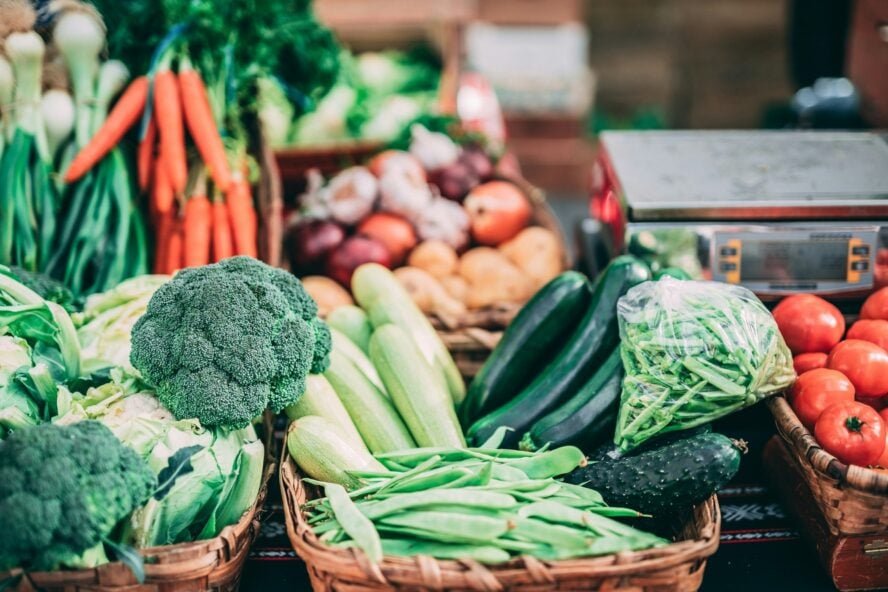
Still, that doesn’t mean it’s a trend that should be jumped into without the appropriate research and consideration. Since everyone’s digestive system reacts differently to new foods, it’s important to learn more about the types of fiber your body needs first — then follow advice to incorporate it safely so you can achieve the most effective results.
This is not a substitute for professional medical advice. See your primary care physician when making changes to your lifestyle.
The Two Types of Fiber Your Body Needs
For optimal health, your body needs a balance of both insoluble and soluble fiber. Insoluble fiber doesn’t dissolve in water, so it helps bulk the stool to support healthy bowel movements3. On the other hand, soluble fiber dissolves in water to form a gel-like texture that can help slow digestion, which helps lower cholesterol and keep blood glucose levels stable4.
Both types of fiber are necessary to keep your body in tip-top shape. You can ensure a good balance of both fibers by incorporating plenty of whole grains, fruits, and vegetables in your diet.
The Science Behind Fibermaxxing
Although there is no research specific to fibermaxxing, there are plenty of studies that show how high-fiber dietary patterns can benefit our health in a number of ways.
Gut Microbiome Optimization
Fiber-rich foods benefit the gut by not only supporting digestive health, but also by helping to balance the gut microbiome5. They do this by providing prebiotic fibers that nourish the good bacteria in the gut, which in turn help those microorganisms flourish.
Not only that, but research shows that dietary fibers, especially soluble fibers, break down in the body to create beneficial compounds like short-chain fatty acids (SCFAs). These can help lower risk of gastrointestinal diseases like irritable bowel syndrome (IBS) and inflammatory bowel disease (IBD)6.
Blood Sugar Regulation and Metabolic Health
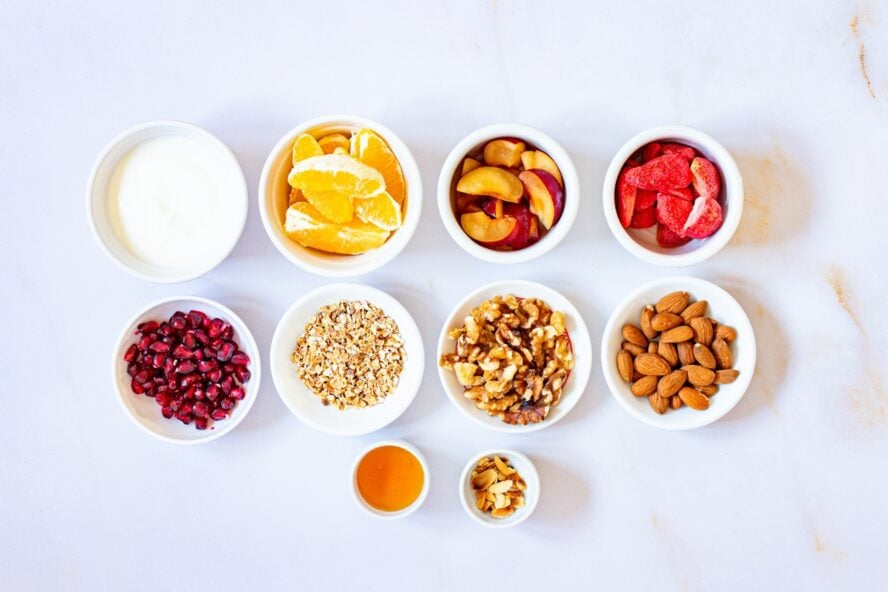
By slowing down digestion, foods rich in soluble fiber like oats, legumes, and fruits can help regulate blood glucose levels and appetite7. These fibers also help to balance lipid and carbohydrate metabolism, insulin sensitivity, and innate immunity, which can improve metabolic health markers and may help with weight management8.
Cardiovascular and Cancer Protection
Soluble fibers can help reduce blood cholesterol levels, which can reduce heart disease risk over time6. Through its role in balancing the gut microbiome, fiber also indirectly helps reduce inflammation in the body. And ultimately, by lowering systemic inflammation, fiber reduces risk of inflammatory-related health conditions like heart disease, type 2 diabetes, and certain cancers6,9,10.
In fact, a 2025 meta-analysis of studies in the journal Critical Reviews in Food Science and Nutrition shows that higher dietary fiber intake was associated with a 22% lower cancer risk, a 17% lower rate of mortality, and a lower risk of digestive tract cancers11. Furthermore, a 2025 review of studies in the journal Food & Nutrition Research shows that high dietary fiber intake can reduce the risk of several cancers, particularly in the digestive, reproductive, and urinary systems12.
The Female-Specific Benefits of Fibermaxxing
While men and women can both stand to gain from getting enough fiber, the research does show there are some benefits specific to women.
Hormonal Balance
A 2025 study in the journal Nutrients reports that dietary interventions like eating a high-fiber diet or increasing antioxidants and omega-3 fatty acid intake can help improve insulin sensitivity, as well as promote hormonal balance in women with polycystic ovary syndrome (PCOS)13. Plus, a 2025 study in the journal Nature reports that a higher fiber intake was linked to a lower risk of endometriosis14. In both cases, the fiber intake helped support the regulation of hormones like estrogen.
PMS Management and Menstrual Health

More good news — a 2025 study on the dietary predictors of premenstrual syndrome (PMS) found that consuming certain high-fiber foods like nuts, seeds, and legumes helped reduce one’s risk of PMS15.
Fibermaxxing Benefits for Men
It’s not just women that reap the benefits! A 2023 study in the journal Nutrition shows that higher fiber intake was associated with a lower cancer risk in men18. Other studies confirm this by showing that the higher the fiber intake, the lower the risk of advanced and aggressive forms of prostate cancer19,20. A 2024 study in BMC Health specifically shows that insoluble fiber intake may have the greatest impact on prostate cancer risk21.
Outside of cancer risk, fiber intake was also linked with improved hormone profiles in men. A 2025 study in Scientific Reports shows that a higher intake of dietary live microbes is associated with a reduced risk of testosterone deficiency22.
How Much Fiber Do You Actually Need?
Spoiler alert: It’s probably more than you think.
Daily Recommendations by Age and Life Stage
Most health experts recommend a minimum fiber intake of 25 grams daily, with the higher end of the range sitting closer to 38 grams daily for men23,24. This is around double of the current average fiber intake in the United States, which is roughly 14 grams daily24.
Daily fiber needs will also depend on age. The Cleveland Clinic recommends 19 grams of fiber daily for children between the ages of 1 and 3 years old. Once a child turns four years old, the fiber recommendations reach 25 grams daily, with preteens and above requiring adult levels of fiber intake for optimal health25.
However, once someone passes the 50-year mark, their fiber intake needs start to decrease. The National Resource Center on Nutrition & Aging recommends that adults over 50 consume between 21 and 30 grams of fiber daily26.
Signs You’re Not Getting Enough Fiber

If you’re not getting enough fiber in your diet, you may experience a sluggish gut — meaning you might deal with constipation, fewer bowel movements, or have trouble straining when going to the bathroom. But gut symptoms aren’t the only signs of a low fiber diet. You might not be eating enough fiber if you:
- Feel hungry very soon after meals
- Encounter trouble managing your blood glucose levels
- Have elevated total cholesterol and/or low HDL cholesterol
If any of these resonate with you, let’s talk about how you can get your fiber intake on track today.
How to Track Your Fiber Intake
If you’re not sure how much fiber you eat per day, we recommend starting with a food tracking app. Using a tracking app can help you identify the starting point of your fiber journey and learn how much fiber is in certain foods and portion sizes. Over time, you won’t need to rely so much on the tracking app to help you meet your daily fiber needs.
The Best Whole Foods for Fibermaxxing
When you think about increasing your fiber intake, the first consideration you might have is your grocery budget. Fiber-rich foods include various fruits, vegetables, legumes, nuts, whole grains, and seeds — none of which you’d necessarily describe as “cheap,” especially in today’s economy.
Luckily, fresh produce isn’t the only source of fiber out there. There are plenty of affordable fiber-rich options in the frozen section and the aisles of the supermarket.
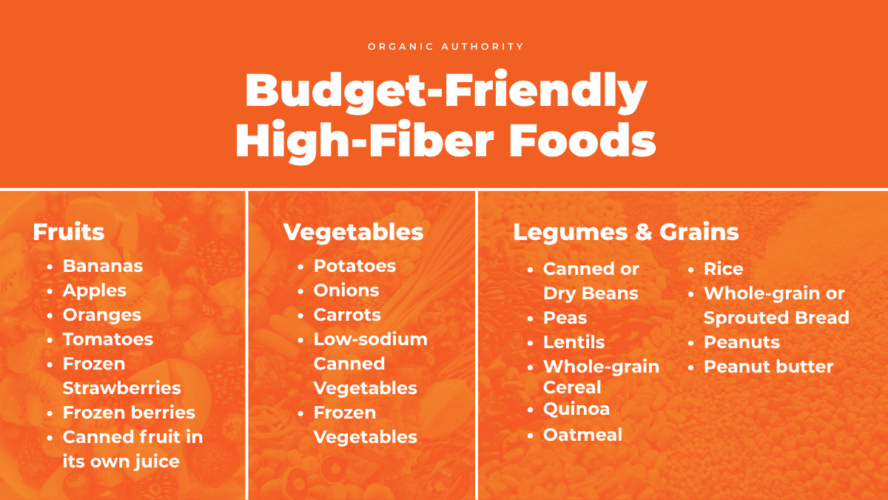
Budget-Friendly High-Fiber Fruits
Here are some examples of high-fiber fruits that won’t break the bank:
- bananas
- apples
- oranges
- tomatoes
- frozen strawberries
- frozen berries
- canned fruit in its own juice
Affordable Vegetables Packed with Fiber
Some examples of budget-friendly high-fiber vegetables include:
- potatoes
- onions
- carrots
- low-sodium canned vegetables
- frozen vegetables
Legumes and Grains
These options tend not to expire quickly, so you can save even more money by stocking up in bulk:
- canned or dry beans
- peas
- lentils
- whole-grain cereal
- quinoa
- oatmeal
- rice
- whole-grain or sprouted bread
- peanuts
- peanut butter
Fiber Sources by Season
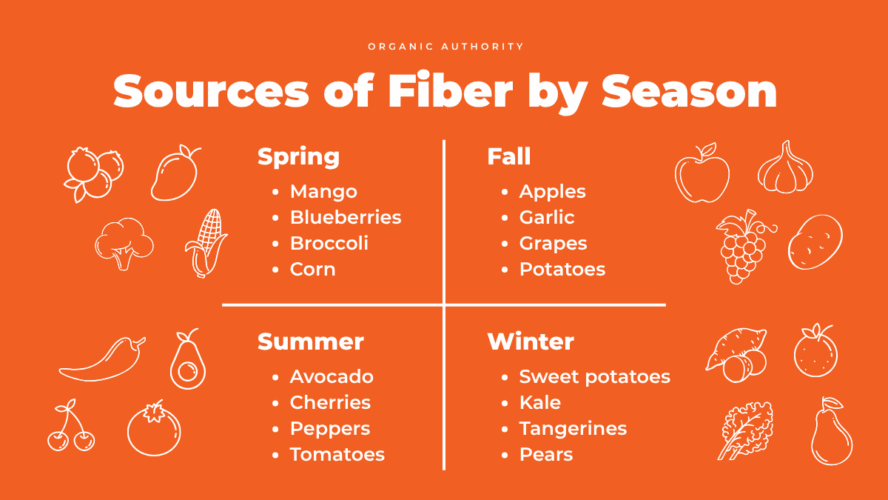
The tastiest way to increase your fiber intake is by choosing fruits and vegetables in their month(s) of peak freshness. Here’s a basic guide to seasonal fiber sources, although these may vary depending on where in the world you live27:
- Spring: In the springtime, you can enjoy seasonal fruits like apricots, avocados, citrus fruits like oranges, lemons, limes, and grapefruit, as well as kiwi, mango, blueberries, strawberries, and honeydew. When it comes to vegetables, artichokes, asparagus, beets, broccoli, corn, cabbage, cauliflower, green beans, and greens like spinach and various lettuces are at their peak flavor.
- Summer: Summertime brings sunshine and an array of tasty fruits and vegetables. Some remain in season from the spring, like apricots, avocado, berries, and citrus fruits — but they’re also joined by cantaloupe, cherries, peaches, plums, peppers, beans, okra, summer squash, zucchini, and tomatoes, to name a few.
- Fall: As the leaves start to fall from the trees, farmers harvest delicious fall produce like acorn, delicata, and buttercup squash varieties, apples, pears, Brussels sprouts, jalapeño peppers, cauliflower, cranberries, radishes, garlic, ginger, grapes, as well as pumpkin, potatoes, turnips, and sweet potatoes.
- Winter: When the weather starts to chill, hearty fall produce like Brussels sprouts, buttercup squash, and sweet potatoes stick around. More wintry fruit and veg like dates, kale, leeks, mandarin oranges, tangerines, collard greens, pears, persimmons, and pomegranate also flourish.
How to Start Fibermaxxing Without Digestive Drama
Here’s what the TikToks won’t tell you — if you go from a daily fiber intake of 10 grams to 30 grams overnight, you’re destined to get your intestines in a twist. That’s why it’s important to follow a gradual increase plan to help ease you into a high-fiber diet.
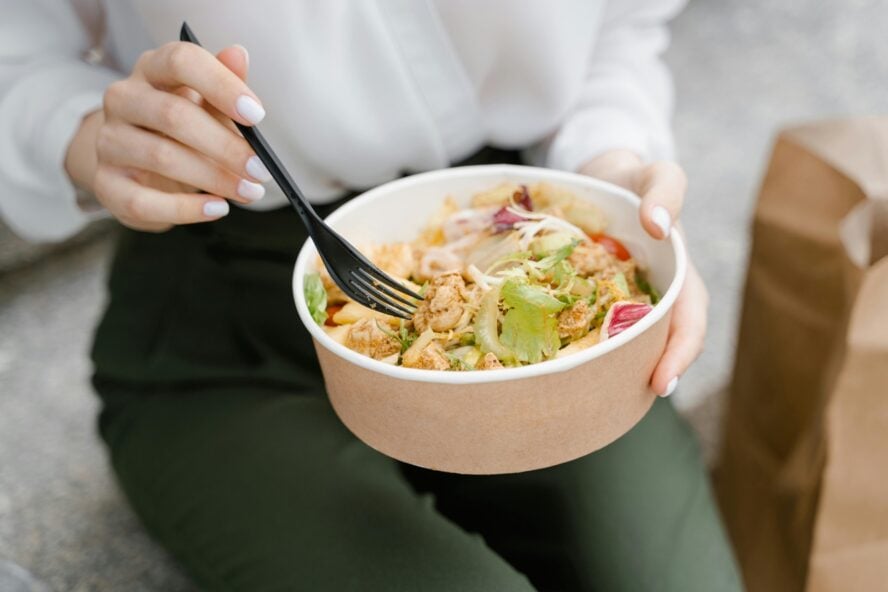
The Two-Week Gradual Increase Plan
Adding too much fiber to your diet too fast can lead to gas, diarrhea, cramping and bloating28. You can avoid (or at least minimize!) discomfort with the following steps:
- Before starting a high fiber diet, track your normal daily intake for a few days to get an idea of what daily fiber level you’re starting from.
- Slowly increase your daily fiber intake by around 3 to 5 grams per day to help your body get used to dealing with more fiber.
- As you increase your fiber intake, also start increasing your fluid intake by about one to two cups of water per five grams of fiber consumed.
- When trying to reach a fiber level of around 30 grams daily, make sure to distribute your fiber intake throughout the day instead of eating it all in one or two sittings. This will help lower your risk of abdominal cramps and gas.
The Critical Connection Between Fiber and Hydration
As mentioned, when you’re increasing your fiber intake, it’s equally important to increase your fluid intake. Fluid will help the soluble fiber swell into a gel-like form to help slow down your digestion and support healthy blood glucose levels. If you don’t hydrate enough while fibermaxxing, then you’ll likely encounter hard-to-pass stools, gas, bloating, and abdominal discomfort that will make you feel miserable.
Daily Intake of Water
As a reminder, the expert-recommended daily intake of water for men and women is 3.7 L/day and 2.7 L/day, respectively29. But water needs may vary depending on the season and where you live, with hotter climates and seasons increasing fluid needs30.
Who Should Avoid Fibermaxxing
Although a high-fiber diet can provide health benefits for most people, not everyone should follow it. Those suffering from flare-ups of digestive conditions like Crohn’s, ulcerative colitis, and diverticulitis should follow a low-fiber and low-residue diet to support symptom management31. Other people who likely shouldn’t follow a high-fiber diet include:
- those recovering from surgery, especially procedures involving the stomach or intestinal tract
- individuals undergoing radiation treatment for cancer which can cause diarrhea and narrowing of the intestines
- people with gastroparesis, or delayed stomach emptying
- those preparing for a colonoscopy or other digestive system exam
These individuals would benefit from a low-fiber diet that minimizes intake of fibrous foods and raw produce, opting instead for easier-to-digest soft, cooked, and fleshy fruits and vegetables32. When in doubt, be sure to consult your physician before making any lifestyle changes.
Meal Planning: High-Fiber Meal Ideas
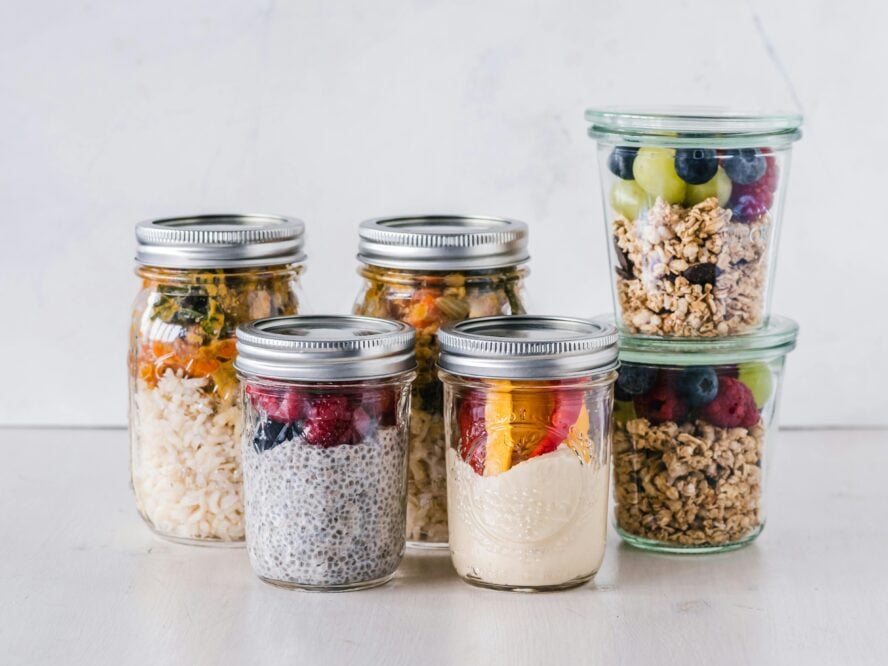
Now that you know how much fiber to eat daily and how to gradually increase your fiber intake, here are some meal and snack ideas to get you started.
- Add avocado: Sliced avocado on toast, mashed avocado veggie dip, or avocado salad are just a few simple ways to add this fiber- and antioxidant-rich fruit to your diet.
- Go green: Find easy ways to incorporate your greens — add spinach to your morning omelet, arugula as a salad base for lunch, and green beans or broccoli as a dinner side for a fiber-packed day.
- Boost your breakfast: Start your morning off right with berries on your morning oatmeal, whole grain toast, or peanut butter granola for a gut-friendly foundation for the day.
- Get grainy: Incorporate whole grains rather than white bread. Try oatmeal, millet, quinoa, or whole-grain rice any time of day for extra fiber and antioxidants.
- Mix up meatless meal days: Make vegetarian days or diets more interesting and fiber-rich with dishes like black bean and quinoa burgers or lentil-based curries.
- Insert fiber into snack time: Whether it’s apples and peanut butter, baby carrots and hummus dip, or a simple bowl of fruit, snack time is the perfect time to help fill any fiber gaps in your daily diet. Some more fiber-rich snack ideas include:
- Granola and berries over a cup of yogurt
- A few cups of lightly salted popcorn
- Whole-grain tortilla chips with homemade salsa or guacamole
- A high-fiber wrap spread with a nut or seed butter
- Soak chia seeds overnight for an easy pudding you can top with nuts or fruit
Beyond the Basics: Advanced Fibermaxxing Strategies
If you’ve mastered the standard techniques of fibermaxxing and have built up your fiber tolerance to the recommended daily values, challenge yourself with these advanced fibermaxxing strategies.
Fermented Foods and Prebiotic Synergy
Adding fermented foods to your high-fiber diet can enhance health benefits by boosting microbial diversity33. Combined with the prebiotics found in many fiber-rich foods like bananas and onions, your body can reap even more of the microbiome-boosting benefits of fermented foods34.
Examples of fermented foods include kefir, sauerkraut, kimchi, miso, and natto35. If these aren’t foods you typically stock at home, a simple way to add fermented foods and prebiotics in your diet is to eat a cup of greek yogurt topped with honey and sliced banana for that prebiotic goodness36. For more savory meals, try sauerkraut or kimchi alongside peas, beans, or barley with your preferred protein.
Timing Your Fiber Intake for Optimal Benefits
For optimal benefits, it’s important to distribute your fiber intake throughout the day to help your body effectively process the fiber. By doing this, you can promote enhanced digestion, lessen the risk of digestive discomfort, and help support healthy sleep patterns37,38.
Supplements vs. Food Sources
When it comes to fiber sources, it may seem easier to just mix a fiber supplement with some water and call it a day. But if you do this, you’ll miss out on the diversity of nutrients found in fiber-rich foods — like antioxidants, minerals like potassium and magnesium, and plant-based protein.
In most cases, fiber-based supplements should be reserved for those that are unable to physically consume the volume of food required to meet fiber needs each day. This includes older adults who may not eat a lot calorically, those with constipation who have a poor appetite, or people with IBS or other digestive problems who are following restrictive diets due to food intolerances.
Frequently Asked Questions
The time it takes to see results from fibermaxxing will depend on what your health goals are. If you’re hoping to reduce constipation, you may start seeing results in the first few days. However, if you’re hoping to lose weight, lower cholesterol, or manage blood glucose, it may take several months to see significant progress.
If you’re drinking plenty of fluid but still feeling constipated or bloated, you may be getting too much fiber. In this case, it can be helpful to track your nutrient intake and ensure your fiber intake is within daily dietary recommendations. If you’re still feeling these symptoms, you may need to start keeping a food journal to try and identify if certain foods or ingredients are causing discomfort.
Fibermaxxing may help regulate your appetite and in turn cause you to consume fewer calories, which may indirectly support weight loss over time. However, this depends heavily on exactly what you’re eating. Ultimately, fibermaxxing should be treated like a holistic lifestyle change rather than a quick weight loss trick.
If fibermaxxing causes bloating, make sure you’re drinking enough water throughout the day with your fiber-rich meals. Other behaviors that can help reduce bloating include moving more each day, taking a daily probiotic supplement, or eating smaller meals. If bloating still persists, speak with your healthcare provider.
Yes! Canned beans, dried beans and lentils, nuts, nut butters, seeds, and frozen fruits and vegetables are some budget-friendly ways to add fiber to your diet.
Sources:
- https://health.clevelandclinic.org/how-much-fiber-per-day
- https://www.eatright.org/health/essential-nutrients/carbohydrates/fiber
- https://pmc.ncbi.nlm.nih.gov/articles/PMC7844368/
- https://www.sciencedirect.com/science/article/pii/S0268005X23000413
- https://pmc.ncbi.nlm.nih.gov/articles/PMC9268622/
- https://pmc.ncbi.nlm.nih.gov/articles/PMC8624670/
- https://www.tandfonline.com/doi/10.1080/10408398.2022.2130160
- https://pmc.ncbi.nlm.nih.gov/articles/PMC8624670/
- https://pubmed.ncbi.nlm.nih.gov/38153313/
- https://pubmed.ncbi.nlm.nih.gov/34140026/
- https://pubmed.ncbi.nlm.nih.gov/38153313/
- https://foodandnutritionresearch.net/index.php/fnr/article/view/11034/18662
- https://pubmed.ncbi.nlm.nih.gov/39861440/
- https://www.nature.com/articles/s41598-024-79746-9
- https://pubmed.ncbi.nlm.nih.gov/40466589/
- https://pmc.ncbi.nlm.nih.gov/articles/PMC10498976/
- https://pmc.ncbi.nlm.nih.gov/articles/PMC11282473/
- https://pubmed.ncbi.nlm.nih.gov/37149919/
- https://pmc.ncbi.nlm.nih.gov/articles/PMC3503404/
- https://pubmed.ncbi.nlm.nih.gov/38636793/
- https://pmc.ncbi.nlm.nih.gov/articles/PMC10799495/
- https://www.nature.com/articles/s41598-025-04521-3
- https://pmc.ncbi.nlm.nih.gov/articles/PMC9268622/
- https://newsinhealth.nih.gov/2010/08/rough-up-your-diet
- https://health.clevelandclinic.org/figuring-dietary-fiber-child-need
- https://www.ncbi.nlm.nih.gov/books/NBK559033/
- https://fruitsandveggies.org/blog/whats-in-season-2/
- https://www.mayoclinic.org/healthy-lifestyle/nutrition-and-healthy-eating/in-depth/high-fiber-foods/art-20050948
- https://www.ncbi.nlm.nih.gov/books/NBK562207/
- https://www.frontiersin.org/journals/nutrition/articles/10.3389/fnut.2024.1463501/full
- https://www.mayoclinic.org/healthy-lifestyle/nutrition-and-healthy-eating/in-depth/fiber/art-20043983
- https://www.mayoclinic.org/healthy-lifestyle/nutrition-and-healthy-eating/in-depth/low-fiber-diet/art-20048511
- https://pmc.ncbi.nlm.nih.gov/articles/PMC12249102/
- https://www.frontiersin.org/journals/microbiology/articles/10.3389/fmicb.2022.908506/full
- https://pmc.ncbi.nlm.nih.gov/articles/PMC12249264/
- https://pmc.ncbi.nlm.nih.gov/articles/PMC6463098/
- https://pmc.ncbi.nlm.nih.gov/articles/PMC11538121/
- https://pmc.ncbi.nlm.nih.gov/articles/PMC11671356/

